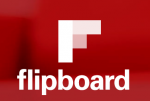 Flipboard is a great app for the iPad. It displays a collections of RSS feeds as a magazine. The latest version (1.1.1) offers the ability to add a Google Reader account, which can contain a multitude of feeds. These feeds can even be categorized. Flipboard can easily display all feeds, the feeds in a category or individual feeds.
Flipboard is a great app for the iPad. It displays a collections of RSS feeds as a magazine. The latest version (1.1.1) offers the ability to add a Google Reader account, which can contain a multitude of feeds. These feeds can even be categorized. Flipboard can easily display all feeds, the feeds in a category or individual feeds.It has the ability to add a Flickr account to show the photos in that account. Unfortunately, Flickr is rather limited in its features: no more than 300MB per month upload.
There are alternatives for Flickr, like Google Picasa, Mediafire or Microsoft Live SkyDrive. Picasa has a storage limit of 1GB, which is even worse than Flickr. SkyDrive has a storage limit of 25GB, but no monthly upload quotum. The best thing about SkyDrive is that it has a RSS feed capability, so you can add it to your Google Reader account and have a magazine of photos. Mediafire has no upload or storage limitations, but no RSS feed capability, which is too bad, otherwise it would be the perfect photo-in-flipboard solution.
Because there is no dedicated Microsoft Live SkyDrive iPad app, this is a nice alternative.
Unfortunately, the RSS XML that SkyDrive returns is not interpreted by flipboard, like it is interpreted by, say, Google Reader, where the photos are displayed directly in the feed. Flipboard displays an empty article, with a link, that, when clicked, redirects to the photo. This is not useful. It turns out that the <link> element is the culprit.
Workaround
- Optionally, create a SkyDrive account. Create a Windows Live / SkyDrive account and create a new folder. Set it as a "photo" folder. Upload some photos to this account. Make a note of the "cid-" code in the URL (or on the SkyDrive webpage). It is the unique identifier for that account. Also make a note of the folder name.
- Create a conversion script that corrects the XML supplied by SkyDrive. Flipboard only displays the photos in the feed items, when the combination of the <link> tags of the <channel> and <item> tags form a valid URL. SkyDrive supplies the complete URL in the <link> tag of each item, so the <link> tag of the <channel> should be empty or not present at all.
- Host the script online. I have created a PHP script called default.php and am hosting it on freehostingnoads.net. An account can be freely created and their PHP configuration support the functionality needed to get HTML code from another website, in this case, SkyDrive. The complete URL to the website is:
http://www.livestreem.freehostingnoads.net/default.php
- Optionally, make the script dynamic. I added the posibility to supply a SkyDrive account id (CID) and folder to the script. Example for CID "cid-dba80f3be68c2301" and folder "genericweb" :
http://www.livestreem.freehostingnoads.net/default.php?cid=dba80f3be68c2301&folder=genericweb
- Add script URL to the Google Reader: add the URL of the conversion script to the Google Reader account. Use the complete URL, including the PHP script name.
So:
http://www.livestreem.freehostingnoads.net/default.php?cid=dba80f3be68c2301&folder=genericweb
and not:
http://www.livestreem.freehostingnoads.net/?cid=dba80f3be68c2301&folder=genericweb
- Optionally, test the feed. Google Reader updates the results from feeds at set intervals, that cannot be controlled. Pressing the "refresh" button is only useful after this interval has passed and Google has updated the feed internally. I use Chrome and, to test the feed realtime, I use the extention/add-on "Slick RSS"
- Add a Google Reader section to Flipboard: login with your username and password. This only needs to be done once. The domain name part of the link tag is used by Flipboard to prefix the text of an item with a bold text containing this text and a small icon. If there is no text, just a photo, it does not do this.
Some downsides:
- History explosion. Google stores the history of a feed. This can be annoying when testing a script with a lot of photos, because they get added again and again. Even worse, after deleting the subscription and adding it later, Google restores the full history! Google remembers the URL's and content of feeds that were added in the past.
- Low resolution. There is no easy way to get the full resolution photo from SkyDrive. It supplies a encoded path to a preview version - most of the time 600x400 pixels - and, when clicked from within the SkyDrive website, redirects to another encoded path for the full resolution.
- Photos are public. The photos need to be in a publicly available SkyDrive folder, unlike Flickr. With the Flickr photostream of Flipboard it is possible to login in with a username and password to a private folder.
SkyDrive ASPX pages
A list of .Net scripts to access SkyDrive:
- self.aspx: returns SkyDrive page for the specified document/photo
- embedphoto.aspx: returns a downsized version of the photo
- embedalbum.aspx
- feed.aspx: returns a XML document describing the RSS feed
- browse.aspx
Update 20110727:
Skydrive has been redesigned. The current feed works correctly with Flipboard, so the workaround above is no longer needed!
